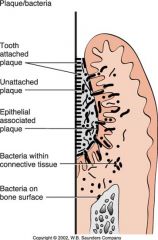![]()
![]()
![]()
Use LEFT and RIGHT arrow keys to navigate between flashcards;
Use UP and DOWN arrow keys to flip the card;
H to show hint;
A reads text to speech;
18 Cards in this Set
- Front
- Back
|
What are the two local effects of periodontal disease? |
Pain and odor |
|
|
The first step in periodontal disease is and acquired pellicle. True or False |
True |
|
|
An acquired pellicle is made up of ______. |
glycoprotein |
|
|
Acquired pellicles are derived from several things. Name them |
Saliva, crevicular fluid, bacterial and host tissue cell products, and debris. |
|
|
How can acquired pellicles be removed? |
With abrasives. (Not rinsing) |
|
|
Plaque is caused by colonization of what type of bacteria? |

Gram positive aerobic bacteria |
|
|
Multicellular communities held together by a self-produced extracellular matrix are called ______. |
Biofilms |
|
|
Put the steps of periodontal disease progression in order from first steps to final steps. Biofilms Invasion of gram neg. bacteria Colonization of gram pos. aerobic bacteria Acquired Pellicle Spirochettes |
Acquired pellicle Colonization by gram pos. bacteria Biofilms Invasion of gram neg. bacteria Spirochettes |
|
|
Just having this can inflame the gingiva. |
Bacteria |
|
|
What about the bacteria causes the inflammation? |
Cytotoxins from gram neg. bacteria |
|
|
Give the steps of pathogenesis of bacterial colonization of teeth. |
Inflammation continues gingiva loosens from the tooth pocket formation gum recession furcation exposure bone loss tooth loss |
|
|
If you see no evidence of attachment loss, and gingivitis, what stage of periodontal disease do you probably have? |
Stage 1periodontal disease |
|
|
If you see less than 25% of attachment loss in an animals teeth and pocket depths of <5mm in dogs and <1mm in cats, what stage periodontal disease do you most likely have? |
Stage 2 periodontal disease |
|
|
If you see less than 25% attachment loss and pocket depths of <7mm in dogs and <2mm in cats, what stage periodontal disease do you probably have? |
Stage 3 periodontal disease |
|
|
If you see greater than 50% attachment loss and pocket depths of greater than 7mm in dogs and greater than 2mm in cats, what do you have? |
Stage 4 periodontal disease |
|
|
What are some systemic influences of periodontal disease? |
Age genetics diabetes mellitus immunosuppressive diseases Gingival hyperplasia |
|
|
Name 3 immunosuppressive diseases that may have an effect on periodontal disease progression. |
FIV FIP FeLV Others |
|
|
What type of medications can cause periodontal disease? |
Immunosuppressive medications |

